
Beetles are a group of insects that form the order Coleoptera, in the superorder Endopterygota. Their front pair of wings are hardened into wing-cases, elytra, distinguishing them from most other insects. The Coleoptera, with about 400,000 species, is the largest of all orders, constituting almost 40% of described insects and 25% of all known animal life-forms; new species are discovered frequently. The largest of all families, the Curculionidae (weevils), with some 83,000 member species, belongs to this order. Found in almost every habitat except the sea and the polar regions, they interact with their ecosystems in several ways: beetles often feed on plants and fungi, break down animal and plant debris, and eat other invertebrates. Some species are serious agricultural pests, such as the Colorado potato beetle, while others such as Coccinellidae eat aphids, scale insects, thrips, and other plant-sucking insects that damage crops.

The family Scarabaeidae, as currently defined, consists of over 30,000 species of beetles worldwide; they are often called scarabs or scarab beetles. The classification of this family has undergone significant change in recent years. Several subfamilies have been elevated to family rank, and some reduced to lower ranks. The subfamilies listed in this article are in accordance with those in Bouchard (2011).

Khepri is a scarab-faced god in ancient Egyptian religion who represents the rising or morning sun. By extension, he can also represent creation and the renewal of life.
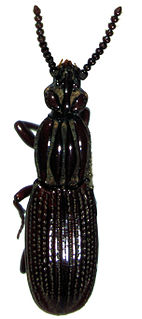
Rhysodidae is a family of beetles, consisting of more than 350 species in about 20 genera.

Dung beetles are beetles that feed on feces. Some species of dung beetles can bury dung 250 times their own mass in one night.

Terrestrial locomotion has evolved as animals adapted from aquatic to terrestrial environments. Locomotion on land raises different problems than that in water, with reduced friction being replaced by the increased effects of gravity.

The scarab beetle subfamily Scarabaeinae consists of species collectively called true dung beetles. Most of the beetles of this subfamily feed exclusively on dung. However, some may feed on decomposing matter including carrion, decaying fruits and fungi. Dung beetles can be placed into three structural guilds based on their method of dung processing namely rollers, dwellers and tunnelers Dung removal and burial by dung beetles result in ecological benefits such as soil aeration and fertilization; improved nutrient cycling and uptake by plants, increase in Pasture quality, biological control of pest flies and intestinal parasites and secondary seed dispersal. Well-known members include the genera Scarabaeus and Sisyphus, and Phanaeus vindex.

Scarabaeus sacer, common name sacred scarab, is the type species of dung beetles in its geenus and the family Scarabaeidae.

Garreta is a genus of dung beetles in the scarab beetle family (Scarabaeidae). There are more than 20 described species; most are African and some are from Asia. They are generally found in fairly moist habitats.

Aphodius rufipes, the night-flying dung beetle, is a species of scarab beetle, first recorded by the zoologist Carl Linnaeus as Acrossus rufipes in his 10th edition of Systema Naturae.

Insect thermoregulation is the process whereby insects maintain body temperatures within certain boundaries. Insects have traditionally been considered as poikilotherms as opposed to being homeothermic. However, the term temperature regulation, or thermoregulation, is currently used to describe the ability of insects and other animals to maintain a stable temperature, at least in a portion of their bodies by physiological or behavioral means. While many insects are ectotherms, others are endotherms. These endothermic insects are better described as regional heterotherms because they are not uniformly endothermic. When heat is being produced, different temperatures are maintained in different parts of their bodies, for example, moths generate heat in their thorax prior to flight but the abdomen remains relatively cool.

Sceliages, Westwood,, is a sub-genus of the Scarabaeus dung beetles, and are obligate predators of spirostreptid, spirobolid and julid millipedes, having renounced the coprophagy for which they were named. The genus is near-endemic to Southern Africa, Sceliages augias exceptionally ranging as far north as the Democratic Republic of Congo.
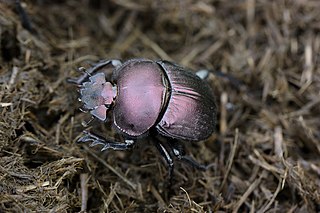
Anachalcos convexus is a species of scarab beetle in the genus Anachalcos.
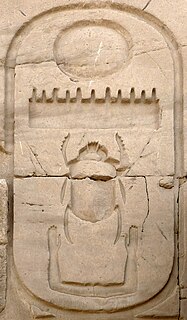
Insects have long been used in religion, both directly and as images or symbols.
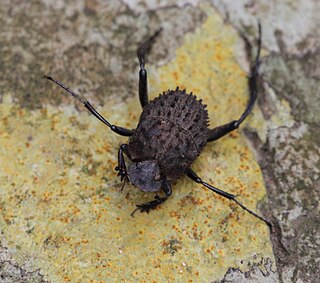
Sisyphini is a tribe of scarab beetles, in the dung beetle subfamily (Scarabaeinae), but it may now be combined with the Scarabaeini. The middle and hind legs are very long; the relatively short body is laterally compressed and has flattened sides. Relative to other dung beetles they are of small to moderate size.
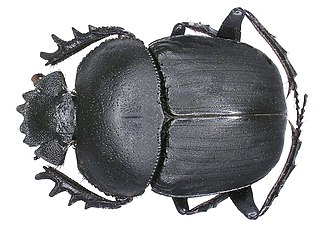
Scarabaeus ambiguus is a species of Old World dung beetles. This beetle rolls up a ball of dung before laying eggs on it and burying it.
Copris signatus, is a species of dung beetle found in India, Sri Lanka and Laos.
Onthophagus heterorrhinus, is a species of dung beetle found in India, Sri Lanka and Myanmar.

The Scarabaeini are a tribe of old-world dung beetles, erected by Pierre André Latreille.
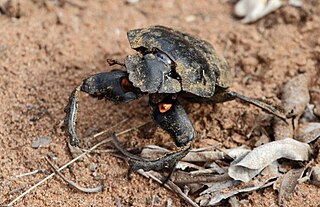
Pachylomera is a genus of dung beetle from the family Scarabaeidae and tribe Scarabaeini, with records from Africa south of the equator.



















